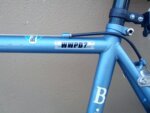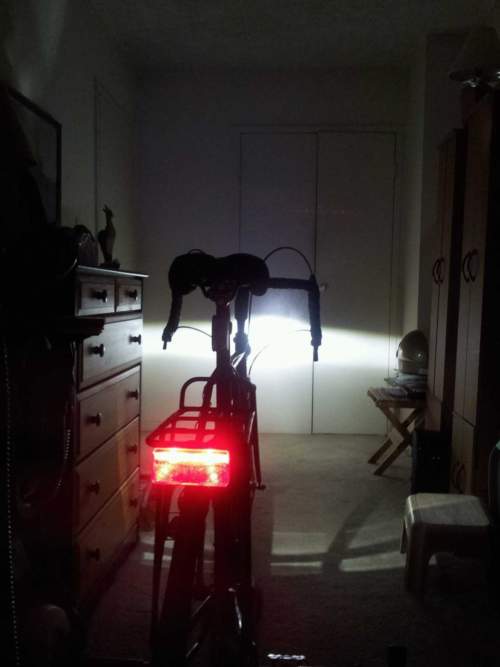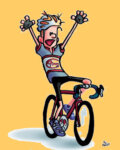Best lighting
Our Community › Forums › Freezing Saddles Winter Riding Competition › Best lighting
- This topic has 21 replies, 11 voices, and was last updated 1 year, 6 months ago by
Meh.
-
AuthorPosts
-
December 4, 2023 at 4:52 pm #1127080
Meh
ParticipantMix of Outbound, Cygolite, NiteRider and Lezyne, depending on the bike. Two 100-150 lumen visibility lights (white front, red rear) low on the bike (fork and seatstay) so they light up the wheel. Usually set to steady so the wheel rotation is apparent.
600+ lumen “see the trail” lights. By 90 minutes-2 hours after dark those ‘600’ lumens are less than 250 so no, that is not overkill. Battery life and switch reliability are the big factors. Cheap no-name brand lights need not apply.
I have a huge Spaninga Thor but I only use that on the MTB because I am nice to other road users. Also, my handlebar lights pivot, for the same reason.
December 4, 2023 at 5:52 pm #1127081 jrenautParticipant
jrenautParticipantI always assume no one sees me because most of the time they don’t. Hard to see a cyclist when you’re watching TikTok on your phone.
December 6, 2023 at 1:40 am #1127089 cvcalhounParticipant
cvcalhounParticipant@Meh 226476 wrote:
600+ lumen “see the trail” lights. By 90 minutes-2 hours after dark those ‘600’ lumens are less than 250 so no, that is not overkill.
Are you turning them down to that, or does the light diminish that fast on its own? Mine tends to stay at the same level of light until it gives up entirely. Of course, I start with a light that is intended to be 1800 lumens, and keep it on low ([FONT="]350 lumens) in order to have maximum battery life, but that’s my choice rather than it going down on its own.[/FONT]
December 6, 2023 at 2:08 am #1127091 cvcalhounParticipant
cvcalhounParticipantI have a lot! I’m mostly riding my Lectric Bike these days, which comes with a built-in headlight and tail light, but I upgraded the headlight to one four times as strong as the original. I also have a NiteRider Lumina Dual 1800 headlight, which I keep on low (350 lumens) so as to give it maximum run time (6 hours). I also have a Cycliq Fly 12, which I normally keep on camera-only mode. (It will record any accident I’m in, which I figure is necessary because a) I assume that if I’m in an accident, I may have a concussion and lose all memory of it, while the driver is fully able to present their side of the story, and b) the police are always inclined to to blame the cyclist rather than the driver for any accident.) However, it also serves as a backup headlight just in case the other two both go out.
On the rear, in addition to the built-in tail light I have the Cycliq Fly 6 (also a video camera, but has no camera-only mode so it serves as an additional tail light). I also have three of the Lumos Firefly lights. They can be programmed with your phone so as to be used as a front light, rear brake light, or right or left turn signal. I have my three programmed to be a brake light, a right turn signal, and a left turn signal. The controller for them (which sits on my handlebars) also controls my Lumos helmet, which has a front light, a rear light, and turn signals of its own.
I then have two Blackburn Grid Beacon Bike Side Lights, which are attached on either side of the stem. I keep them on flash/high, which means 85 lumen and 3 hours run time. Although I have wheel lights, they aren’t nearly as visible as the beacon lights.
And don’t forget reflectors! I biked behind a friend at one point, and realized that even with just my bike headlight, not a car one, the reflectors were a whole lot easier to see than the lights. So in addition to the reflectors on the bike and the panniers, I wear startlingly reflective clothing. That’s the Proviz REFLECT360 cycling jacket for spring and fall. (It is so reflective, it glows!) The Proviz REFLECT360 quilted synthetic down jacket for winter. When it is too hot for a jacket, I wear an ANSI Class 2 reflective vest (the kind road construction workers wear). And if it is too cold even for the quilted Proviz jacket, I wear the ANSI vest over my electrically heated jacket or my LL Bean down jacket.
December 6, 2023 at 3:03 am #1127094dbb
ParticipantMy winter kit often includes a Niterider mounted to my helmet so if I think a motorist doesn’t see me I can direct the beam to a location where it might be a bit more noticable such as their face. On the trail the helmet light is typically dark. For the trails, I use a combination of Niteriders of varying strength, maxing out at about 600 lumens. The older Niteriders had a rapid flash mode that was quite noticeable, but my newer ones have a slower flash that isn’t quite as siezure inducing.
December 6, 2023 at 3:57 pm #1127104 arlcxriderParticipant
arlcxriderParticipantYeah, I use dual headlights as well. One handlebar mount, and one on the helmet.
The combo seems to be more attention-getting than a single headlight. Plus the helmet light is aimable through tight corners on trails and whatnot.
Redundancy is a good thing, too. Keeping everything charged requires organization.
December 6, 2023 at 4:24 pm #1127107Meh
Participant@cvcalhoun 226487 wrote:
Are you turning them down to that, or does the light diminish that fast on its own? [/quote]
Very much on their own – note that only my Thor is rated to anywhere near 1800 so my lights/batteries are considerably smaller than yours, and physical size absolutely matters when running in the cold.
90 minutes without *noticeable* fade is about what I absolutely count on. There is also subtle fade one doesn’t notice until after one charges it back up again.
December 6, 2023 at 8:24 pm #1127114mstone
Participantmy biggest must-have is a shaped beam with a sharp cutoff to avoid blinding others. it also makes better use of the available light, with even illumination over a wide area rather than a bright blob up close.
December 6, 2023 at 10:03 pm #1127115Meh
Participant@arlcxrider 226501 wrote:
Yeah, I use dual headlights as well. One handlebar mount, and one on the helmet.
The combo seems to be more attention-getting than a single headlight. Plus the helmet light is aimable through tight corners on trails and whatnot.
Redundancy is a good thing, too. Keeping everything charged requires organization.
Yep! Also notice that dual, non-blinking headlights get the attention of camera-based traffic signals faster.
(Fairfax County, I’m looking at you)December 7, 2023 at 4:16 am #1127119 StardusterParticipant
StardusterParticipant#Vezzaford, welcome back! If I may offer my own input, based on 10 years as a bike commuter (The Bicycle Exchange, VA), all the Monuments at Night rides I led for Papillon Cycles, and a self taught “Universite du CIBIÉ” education…
I have always considered a bicycle “incomplete” unless it is set up for night work. It is confining to be limited to daylight hours. With great lights, night riding can be an *absolute blast*. But it can get very scary very quickly if your lights fail you. Being seen is important, but *being able to see* is more so. Quality lighting is now available regardless of the format you choose- rechargeable battery, permanent dynohub installation, or E-bike.
For *off-road* trail riding, there is already plenty of product out there. Perfect, provided you don’t point your driving lights at oncoming cyclists (que the “Cover your lights!!!” rant). If you are illuminating someone’s face, you are blinding them. Simple. But most of us are riding on the street or the W&OD, with oncoming traffic. I run European spec *layered beam* headlights from Busch+Muller on everything but my vintage Peugeot (which carries period correct “glowing filament” lighting. I have the other bikes for serious night work). These lights have a sharp cutoff, for maximum forward range *without* blinding oncoming traffic. *Just like* a good automotive low beam headlight- the headlights we and our parents and grandparents grew up with. Many of them designed to meet European road approvals. The best known of these are the German road traffic standards- StVZO. If you ride a recent E-bike, you likely already have a headlight like this installed as original equipment. That’s a *good* thing. Even better, we’re now seeing switchable low beam/high beam lamps for the trail. Just like a motorcycle…


First & 3rd pics are a B+M CYO Premium, showing the sharp cutoff, and a wide even spread of light with forward range. The 2nd, a more recent B+M IQ-X, which my Trek 412 currently runs. I should mention that *both* USB-rechargable and permanent dynohub lights offer the same output levels now. E-bike standards & requirements have evolved to now allow even more lumens & lux plus a high beam function. Regardless, just like your headlights on the car, you should properly aim those lights for best results, keeping the top of the beam’s hot spot at or below 0 degrees horizontal. These lights are no longer the exclusive province of the Europeans- Busch+Muller, SON/Schmidt, or Supernova. Check out product from Trek (their Kindbeam lamps) or Outbound Lighting.

On my wife’s Breezer, battery powered Euro-spec taillights from B+M and Spanninga. Both steady lights, and despite their diminutive size, each is motor-vehicle-taillight bright, as they should be. Most new E-bikes are equipped this way.
On flashing lights…Be honest, they are a *defensive* lighting measure needed to make sure a distracted/inattentive motorist sees you. Hopefully. Such is our reality on the streets. It should not be, but it is. But *not* needed on the bike trail, where you are the biggest meanest whatever on the trail. If you run bright flashers on the road after dark, I recommend pairing them with a steady light. I found it is difficult for a driver to accurately judge closing distance to a blinking light. I, as a driver, once had a close call with a cyclist that way.
Hope I haven’t thrown too much at you. But I also want you to be safe out there.
December 7, 2023 at 1:18 pm #1127120mstone
Participantyes, blinking lights are definitely a mixed bag. in theory they’ll make someone notice you, with the assumption that once noticed they’ll avoid you, but a whole lot of emergency vehicles with far more blink than you’ll ever fit on a bike get hit every year so there seems to be a gap between theory and practice. I use blink only on-road during the day, mainly as a battery saver for some increased visibility vs turning them off entirely. I think the germans still ban blinking lights, and IMO they tend to have the best-considered bike lighting regulations.
December 7, 2023 at 5:20 pm #1127125 Steve OParticipant
Steve OParticipantNote that you need lights for two different reasons: to see and to be seen. If you always ride where there are streetlights, etc. then your lights are primarily “to be seen.” If you ride on the dark trails, then you need lights “to see.” You may need both.
Just as important for riding where there are drivers is to be reflective. For daytime riding, hi-viz colors are useful, but they do not reflect at night unless they have reflectivity also built in. Bright colors alone do not make you visible at night. It’s very useful to have something reflective on things that move, like your pedals, because it really alerts drivers to the fact that there is a bicycle.
December 7, 2023 at 5:49 pm #1127128Meh
ParticipantAgreed, with the specific note that we’re talking about retro-reflective “corner reflector” or “cat eye” type reflective. Reflective safety tape is cheap and can be put on very many surfaces.
In order for a driver to see you in *just* bright colors, the driver needs to blind you. For bright colors, the light the driver gets back is only 1/4 of what you see.
Hi-Viz is actually hi-viz (as opposed to just bright) only when UV light is present.Retroreflectors get around the 2x distance means 1/4 light problem by shining the beam back along almost the same angle as it came in.
December 7, 2023 at 6:52 pm #1127130mstone
Participant@Steve O 226523 wrote:
pedals, because it really alerts drivers to the fact that there is a bicycle.
Yes, as a driver the number one thing that tells me there’s a bike ahead are yellow pedal reflections moving up and down. I try really hard to see cyclists, but too many presumably have no idea how invisible they are. Small blinkies or low-wattage taillights are basically useless, they get lost in all the other ambient lights. Combine that with a fashion-forward drive to remove all the “ugly reflectors” and you’ve got a recipe for disaster. (Reflectors will generally be brighter than a small light because they’re powered by the car’s own high-wattage headlights rather than what can get squeezed out of a AAA or coin cell.) Have both a taillight and a rear reflector. Good lights aren’t cheap, but still cheaper than a visit to the hospital. “Testing” lights by looking at your bike in the dark is very different than what’s seen by a driver on the road. Clothing color basically doesn’t matter, neither white nor black can be seen relative to something reflective.
December 7, 2023 at 8:08 pm #1127098jlamb
Participant -
AuthorPosts
- You must be logged in to reply to this topic.